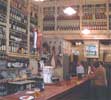
Seville Gastronomy

Seville's culinary heritage is the result of the influences of the many cultures that have shaped the history of the city. Arabic influences are particularly strong, and some dishes, such as gazpacho, of Semitic origin, have spread to other Andalusian provinces and even to the rest of Spain. Seville's gastronomy is characterised by variety and quality. Andalusian cuisine has a strong influence on Sevillian dishes, often in perfect symbiosis, and the most typically Andalusian dishes are a popular part of Sevillian menus. Dishes are generally light, made with fresh ingredients and enhanced with olive oil, Seville's culinary star.
Sevillians know all there is to know about good eating and even more about bringing out the full flavour. The city has an impressive number of bars, restaurants and caterers, where excellent culinary skills come into play to produce dishes that are perfectly prepared and presented. Under the motto "Guarantee of Quality", the Hotels and Caterers Association (Asociación de Hostelería) is promoting a project to involve Sevillian restaurants, bars and cafeterias in an ongoing process to adapt to new needs, by incorporating new cultural influences, accommodating customers' wishes and demands, striving to provide the best culinary offerings, ensuring that all products and ingredients are top-quality and providing good service and hospitality, all at very competitive prices One of Seville's culinary classics is gazpacho, a chilled tomato soup. The recipe evolved as new ingredients were brought from the Americas in the 17th century. The diversity of tastes and ingredients means that different regions now have their own variation of gazpacho, for example, Cordova's salmorejo.
Seville's culinary highlights include the above-mentioned gazpacho, stewed oxtail, loin of pork in lard, menudo (a variation of Andalusian-style tripe), pot-roasted beef (with olives and white wine), the famous pringá (mixture of beef, pork fat back, cured sausage, blood sausage and ham), cod in a tomato sauce and spinach with chickpeas, made according to a recipe inherited from the Moors.
However, the linchpin of Seville's culinary status is the famous tapa, which is a tasty pre-meal morsel served in bars. It is a time-honoured custom to go out with friends for tapas and a glass of beer or wine at midday or in the evening, a tradition that all those who visit the city soon learn to enjoy.
Although bars throughout Spain serve tapas, in Seville they are part of a culinary adventure heightened by ritual and cultural connotations. The tapas ritual involves a movable feast including everything from the most elaborate hot dishes to simple light, cold snacks. The Sevillian bars specialise in distinctive tapas and often cook up new inventions, coining new names. The fact that tapas are snack-sized allows you to sample a variety of flavours without feeling too full.
The tapas tradition has been put down and extolled, expressed and suppressed, criticised and praised, but it lives on in a state of constant experimentation, evoking its origins, adapting to new tastes, pleasing the purists; true to tradition, yet in constant flux.
Seville's sweets and cakes also deserve a special mention. Some of the finest are made in enclosed convents, for example, the exquisite candied egg yolks (yemas) made at the San Leandro convent and held in deservedly high esteem. The recipe for these sweets is a secret jealously guarded by the nuns who still make them in the traditional way. Other examples are the jams made by the Santa Paula Order, the cakes and doughnuts filled with candied citron made at Santa Clara, the assorted pastries made at Santa Inés and the ring-shaped cakes made at San Clemente. In contrast to the products of the big multi-nationals and industrial bakeries, the sweets and cakes produced by the nuns preserve the traditional way of baking and the use of natural products, the essential ingredients of recipes jealously guarded down the ages.
Sevillian bakeries, which sprang up during the era of Moorish Andalusian splendour, became famous in the Renaissance period, and some survived until very recently. It was these bakeries that began to make tortas de aceite, round flat crispy cakes that were distributed all over Spain and exported abroad, and polvorones, a Moorish sweet traditionally eaten at Christmas time, of which there are now an enormous variety. Other famous cakes include cortadillos (cakes filled with candied citron), pestiños (honey-coated pancakes), piñonates (candied pine nut cakes), macaroons and quince preserve.
The fertile orchards in the province of Seville provide an abundance of juicy, flavourful fruits that vary according to the season. When candied and jellied, they are a treat worthy of the highest praise. The wonderful oranges from the hillside orchards and melons from the Sevillian town of Marchena are worth a special mention. Some of Seville's best wines are made in El Aljarafe, whose young wines compete on national and international wine markets.
Seville Spain information



